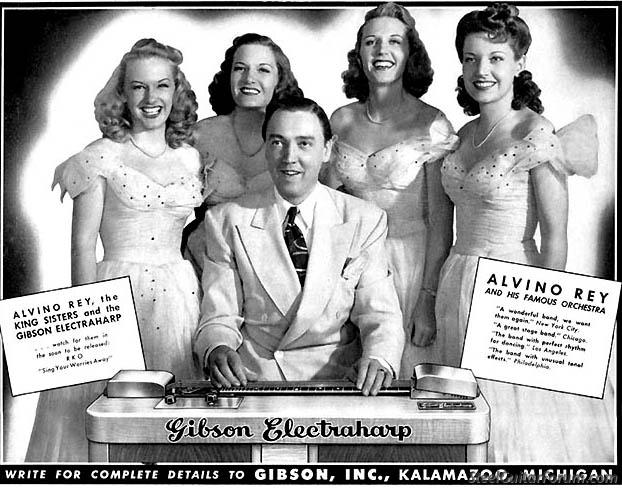Difference between revisions of "Alvino Rey:Mormon Musician"
(Created page with "300px|thumb|alt=Alvino Rey Mormon musician|left '''Alvino Rey''', born Alvin McBurney, was an American swing era musician. He was considered a pioneer in...") |
|||
| Line 26: | Line 26: | ||
[[Category:Famous Mormons]] | [[Category:Famous Mormons]] | ||
| + | {{DEFAULTSORT:Rey, Alvino}} | ||
Revision as of 22:12, 29 July 2021
Alvino Rey, born Alvin McBurney, was an American swing era musician. He was considered a pioneer in the music industry, inventor of the pedal steel guitar, and a virtuoso of the steel guitar.
Rey was born in Oakland, California, on July 1, 1908. He and his family later moved to Cleveland, Ohio. He possessed an aptitude for mechanics and built his first radio at the age of eight. He soon became one of the youngest licensed ham radio operators in the United States.
He was equally gifted in music. He received a banjo for his tenth birthday and began studying the guitar at age 12. He combined both passions when he invented an electrical amplifier for the guitar at the age of 15.
While in Cleveland, Rey played banjo with Ev Jones’s orchestra. He spent two years in New York playing electric guitar with Phil Spitalny’s orchestra. In 1929, Rey officially changed his name to Alvino Rey due to the Latin music craze happening in New York at that time. In the early 1930s, he moved to California and played steel and Spanish guitar for Horace Heidt’s Musical Knights. Rey had a unique sound and became well known for his electric guitar.
Walter Carter, a former Gibson guitar company historian, said, “For millions of radio listeners, the first time they heard the sound of an electric guitar, it was played by Alvino.”[1]
Rey was hired by the Gibson guitar company to produce a prototype pickup—based on the one he developed for his banjo—with engineers at the Lyon and Healy Company in Chicago. The pickup was used on Gibson’s first electric guitar. The prototype is kept in the Hendrix Museum in Seattle, Washington, also known as the Experience Music Project museum.
While playing for Heidt’s Musical Knights, Rey met and married Luise King, one of the King Sisters. They had three children.
Rey soon formed an orchestra with the King Sisters and Frank DeVol. Notable singers and arrangers were part of his band throughout its history. At its zenith, the band filled in for Dinah Shore at New York’s Paramount Theater and recorded top ten hits and appeared in Hollywood movies. A recording ban by the Musicians’ Union in 1942 caused the band to flounder and consequently to disband.
In 1939, Rey created a unique combination of guitar and vocals by using a carbon throat microphone to modulate his electric sound while his wife sang along with the guitar lines. The sound was first called “Singing Guitar” and later became known as the Sonovox. A Soundie film of Rey using the Sonovox is still posted on YouTube.
In 1944, Rey joined the U.S. Navy and became a radar maintenance technician after attending the Electronic Training Program. He also led a service band, and when he was discharged in 1945, he led several small bands. In the late 1950s, he was musical director for the King Sisters and their five-season ABC television series The King Family Show. Rey also led a band that played at Disneyland each year from its 1955 opening.
Rey moved to Utah with his wife in the early 1990s. He and his wife retired in 1994. Rey joined The Church of Jesus Christ of Latter-day Saints after his marriage to Luise King. She died in 1997 and Rey died on February 2, 2004, from complications after breaking his hip.
